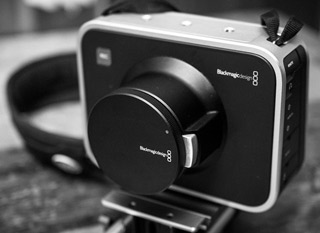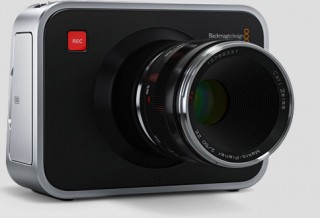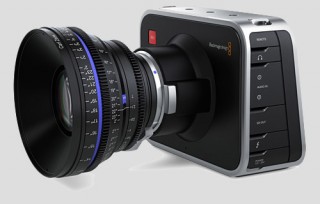 CVP the British reseller for professional camera gear got a visit from Blackmagic and had a chance to try the 2.5K Cinema Camera. In their blog post they talked about many important points giving us a good reminder of what the Blachmagic Cinema Camera will be. They mention some major downsides like the BMCC’s unergonomic design, it’s weight, the small sensor size and lack of shallow depth of field as well as the weak out-of-the-box lowlight capabilities. Apparently the camera only goes up to ISO 1600, but the real question about ISO is what can be pulled out of the BMCC’s RAW files…
CVP the British reseller for professional camera gear got a visit from Blackmagic and had a chance to try the 2.5K Cinema Camera. In their blog post they talked about many important points giving us a good reminder of what the Blachmagic Cinema Camera will be. They mention some major downsides like the BMCC’s unergonomic design, it’s weight, the small sensor size and lack of shallow depth of field as well as the weak out-of-the-box lowlight capabilities. Apparently the camera only goes up to ISO 1600, but the real question about ISO is what can be pulled out of the BMCC’s RAW files…
Read on for the full article:
Here’s CVP’s blog post: (most important stuff is marked bold)
The first thing that everyone at CVP who hadn’t previously seen the camera at NAB said was “I really didn’t expect it to be that big!” – It seems that most people expect the Cinema Camera to be not much bigger than an iPhone, yet the reality is that it’s a fairly chunky unit that weighs in at a hefty 1.8Kg for the body only… At this weight it’s far heavier than an SLR and the lack of any natural handgrip position means that in standard form it’s really suitable for tripod mount use only. BMD are offering an optional pair of ‘cow horn’ style handgrips which will facilitate comfortable handheld use, however with both hands on the grips any kind of on-shot camera adjustments will be impossible without a focus puller and / or a (yet to be invented) BMD Cinema Camera remote control system!
 The prototype was fitted with a Canon EF 24-70 f/2.8 zoom lens and the camera’s approximately mFT (Micro Four Thirds) sized CMOS sensor delivers a crop factor of just over 2:1 when compared to using the same lens on a 35mm full-frame camera such as a Canon EOS 5D, so to achieve ‘standard’ angles of view you’ll need short focal length lenses (approx 24mm). At 24mm f/2.8 (or any other setting) the camera’s depth of field is not as shallow you can achieve with a larger Super 35mm or full frame sensor equipped camera, so in order to get a shallower depth of field I would want to use either Zeiss’ new T/1.5 CP.2 Super Speeds or Canon’s f/1.2 prime lenses.
The prototype was fitted with a Canon EF 24-70 f/2.8 zoom lens and the camera’s approximately mFT (Micro Four Thirds) sized CMOS sensor delivers a crop factor of just over 2:1 when compared to using the same lens on a 35mm full-frame camera such as a Canon EOS 5D, so to achieve ‘standard’ angles of view you’ll need short focal length lenses (approx 24mm). At 24mm f/2.8 (or any other setting) the camera’s depth of field is not as shallow you can achieve with a larger Super 35mm or full frame sensor equipped camera, so in order to get a shallower depth of field I would want to use either Zeiss’ new T/1.5 CP.2 Super Speeds or Canon’s f/1.2 prime lenses.
The Cinema Camera’s native sensitivity is a healthy ISO400 and at f/2.8 it delivered fully exposed images in our fairly dimly lit studio set. Sensitivity can be increased to ISO800 and 1600 for lower light environments and the increase in noise was minimal. Adjusting the EF lens’ iris is easy using the |< and >| buttons, however it is stepped, so for precise or in-shot iris adjustment you’ll need a proper manual iris lens.
The camera features both Thunderbolt and HD-SDI terminals, so we connected the camera’s HD-SDI output directly to a 42″ monitor and framed up a few shots in the demo studio. Unfortunately the prototype was far from complete and non-recording so I can’t share any captured images with you, but what I can confirm is that the output images were surprisingly good considering the camera doesn’t feature any internal gamma curve adjustment or presets – Instead it’s set up to capture the widest possible dynamic range which can then be colorised in post production using the bundled Da Vinci Resolve software application (or any 3rd party grading software). What this means is that in its native form, in most cases, untreated footage from the camera will look washed out… It’s therefore aimed primarily at non-live productions!
 The camera is equipped with a peaking function for accurate focusing – This is activated by a physical ‘focus’ button and it greatly facilitates accurate determination of the focus point, even with the integrated monitor… And on the subject of that monitor I was pleasantly surprised with its image quality and also the clarity and ease of operation of the touch screen menu system. Whilst only a limited number of set up parameters could be changed on the prototype, where adjustments could be made it was a cinch! The brightness & contrast of the display will be adjustable through the menu system, however the prototype was preset to a fairly low brightness level suitable for use indoors – I’m hoping that the panel can be set bright enough to allow outdoor use, as otherwise a third party EVF will be essential. Actually, the truth is that if you buy one of these cameras you will need a third party EVF for handheld operation anyway! It’s worth noting that the pictured LCD viewfinder sunshade (hood) is included with the camera.
The camera is equipped with a peaking function for accurate focusing – This is activated by a physical ‘focus’ button and it greatly facilitates accurate determination of the focus point, even with the integrated monitor… And on the subject of that monitor I was pleasantly surprised with its image quality and also the clarity and ease of operation of the touch screen menu system. Whilst only a limited number of set up parameters could be changed on the prototype, where adjustments could be made it was a cinch! The brightness & contrast of the display will be adjustable through the menu system, however the prototype was preset to a fairly low brightness level suitable for use indoors – I’m hoping that the panel can be set bright enough to allow outdoor use, as otherwise a third party EVF will be essential. Actually, the truth is that if you buy one of these cameras you will need a third party EVF for handheld operation anyway! It’s worth noting that the pictured LCD viewfinder sunshade (hood) is included with the camera.
One of the major differences between this camera and every other dedicated camcorder on the market is that more in common with Apple’s iPhones, iPads & iMacs the BMD Cinema Camera has a non-removable internal battery. This battery allows only about 1.5 hours of constant operation between recharging, so if you want to use it on location you will definitely need a supplementary battery system for all but the most brief of shoots.
Whilst we’re on the subject of the extras you’ll need in addition to the camera body itself here’s a quick list of the essentials:
– Lenses
– BMD approved SSD Media
– Supplementary battery power supply & cable
– Solid ND Filters
– Matte Box
– Rig & EVF for handheld & shoulder-mount use
Of course the number 1 question we asked is “When do we get our stock” and the absolute truth of the matter is that Blackmagic are un-reassuringly vague on this point, saying merely that deliveries will start in July BUT at the moment precise dates and delivery quantities can’t be confirmed!
via CVP
If you’re based in the US you can order the Blackmagic Cinema Camera for $2995 at B&H: LINK
CVP has it for £2,148.00 and serves the European market: LINK























